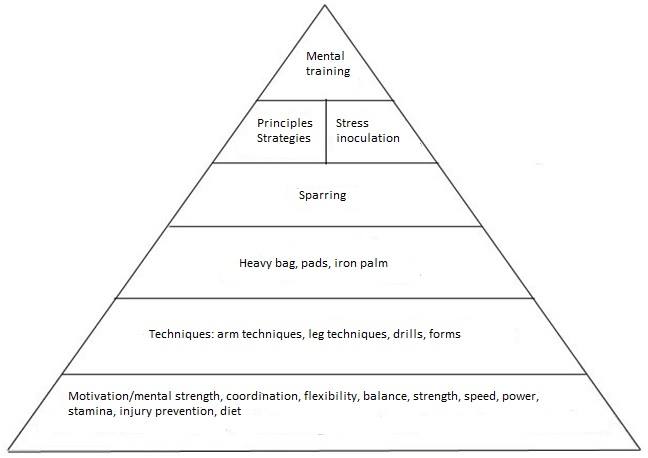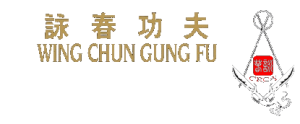Wing Chun split into Elements
Wing Chun is a big pool. How much water can you take, however, it is up to you. This is a good sentence indicating that the elements that make Wing Chun are many and which must amalgamate, so that each element is part of the whole and the whole is formed by the contribution of each element.
For analysis purpose, however, it is better to examine the various elements individually and use a new structure: the pyramid.
The pyramid that I take into consideration is inspired by the Rooney’s and adapted by me to Wing Chun.
Here it is:

Why a pyramid structure? Because, as in a normal building, you have to start from the bottom by building one floor at a time and the lowest level must be so strong as to support the plans that are above.
Let’s see them one by one.
The base
Like any base, also the one our pyramid must be solid. The more solid is the basis, the more stable will be the entire structure.
At the base we find different elements, some physical, some mental, some concerning the behavior.
Motivations are the things that prompted us to begin the practice of Wing Chun. Everyone will have their own. Motivations are essential for understanding our goals and ensure that the training will meet those goals. Note that “finish the system” to me is not a goal but an instrument, or an intermediate step to achieve a goal. It is like trying to learn to drive a car to keep it in the garage and drive occasionally round the block.
Finish the system is a natural condition for anyone who begins the training.
Mental strength is what we need to bear the training. It can be a mental strength to withstand the fatigue (or pain) of the training or even the patience, very important in Wing Chun.
Motivations and mental strength combined, create the “reliability” of the practitioner in training.
For “reliability” I mean constant attendance at training sessions and commitment during the sessions.
We then go to purely physical / athletic attributes: coordination, flexibility, balance, strength, speed, power and endurance.
Injury prevention.
Here the responsibility is split between teacher and student.
For injury prevention I mean:
1) The achievement of awareness, and evaluation ability, of the point and the limits of physical ability in terms of strength, balance, flexibility and strength so the practiotioner doesn’t exceed and hurt himself;
2) Alternate adequately activity and rest/recovery period;
3) Use the appropriate kind of training to your own physical and technical level;
4) Always use the proper equipment for the activity you’re doing;
5) Always keep the mind focused on what you are doing.
Diet
Wing Chun tell us how and what should we eat? Of course not. What is meant here is that adequate food has a dual beneficial effect:
1) It improves our body and our health. It is said that we are what we eat;
2) Following a diet assumes that we adjust our behavior to rules. It a behavioral training, an attitude that will be useful during practice.
But this means that the Wing Chun practitioner can never “go out of the rules”? Of course not. Let us remember that as a good Buddhist style, there is always the middle way. The ability to set and see if we are in the way to the goal is the real goal.
Technical specifications
Here we are in the real technical training.
At this level are covered:
1) All single techniques with the arms and legs;
2) The forms;
3) All the drills and all the patterns.
Impact training
The knowledge of all of the techniques and drills is not useful if at the first impact the wrist, the fist or any other part of the body that is hitting, will break.
That’s why at the upper floor there is the impact training.
This can be done:
– At the heavy bag;
– Using shields, pao, focus glove…;
– Training the Iron Palm sequence, or “conditioning” the various parts subject to impact.
Even if it is not the most important kind of training, even the wooden dummy can be used as impact training for conditioning arms and legs.
Sparring
The next level is the practical application of techniques in a free environment.
Principles and strategies and/or “stress inoculation”
On this level, I put two very different elements together. I did it because they could be the crossroad that leads the practitioner to take one way rather than the other, emphasizing one of these elements.
Principles
Up to this point the practitioner has trained his body and the practical application of Wing Chun. He is now ready to understand the rules from which come techniques and drills. He is ready to understand the principles of Wing Chun.
his will allow him to break free from the chains of the drills. It will allow him to have personal applications that still will respond to the system principles.
Finally he stops being a robot and Wing Chun will become like a dress that will suit perfectly him.
By understanding the principles, the practitioner will also realize the various strategies in Wing Chun, which will enable him to adapt the fight to his opponents and not try to fit all the fights to a single strategy.
Stress inoculation
Many people learn Wing Chun for self-defense.
Wing Chun, as a tool to deal with other human being, can certainly also be used in for self defense.
There is a little problem, that sometimes is forgotten, until someone unfortunately is involved in that kind of event: an aggression, a “street fight” creates a high stress. Stress drives our body and our mind in a way completely different from how they work in the gym.
The greater the stress, the greater the psychophysical changes: adrenaline shot into the circulation changes functioning of the muscles, heart beats increases and the mind gradually decreases the ability to do “fine” movements.
The nice thing is that the amount of stress is personal, it depends on the individual evaluation of the danger.
It means that the same event can be traumatic for someone and a walk in the park for another one.
Training for years and not be able to fight when we need, could be more traumatic than the event itself.
It ‘my opinion that those who approach Wing Chun for self defense should become familiar with the effects of stress on their body and their mind.
But there is a little problem: the stress of a real fight cannot be reproduced in the gym!
What can be done then?
Two things:
1) Train and repeat to exhaustion the correct techniques;
2) “Get vaccinated” to stress.
Let’s start from the first thing: repeat techniques and sequences.
This is one of the things that nowadays are criticized in Wing Chun. Why do I have to repeat, repeat, repeat, repeat …?
It is seen as something archaic and based on an outdated education system.
Instead the repetition has its own beneficial effect during stress: in a fight with a very high stress factor, you will not elevate yourself to the level of the comparison, but you will go down the level of training.
It means that when things get really serious and you perceive a real danger, the mind and the physical adapts to it. If the danger felt is really high, we take what we might call the “automatic pilot”.
If you have witnessed or have heard stories of people after a fight and they said they did not remember what they had done, you have an idea of the “automatic pilot”.
The good news is that the “automatic pilot” does it all on its own, even though we have retreated in the most protected corner of our mind to pray. The bad news is that the automatic pilot takes resources from instinct and instinct is only built by repetition of gestures.
If repetition is correct, the “autopilot” will act properly, otherwise it will do exactly the mistakes done in training.
“Get vaccinated to stress”
As we have seen, fighting is stress, and stress creates physical and psychological changes.
These changes are good until a certain point: the body prepares itself to do 2 of the 4 “F” – fight or flight.
These changes are good. Up a certain point, however, they start to work against us.
What can be done then?
We use the fact that the level of stress depends on our perception. If we change the perception, we will also change the level of stress.
To do this is a little as with vaccinations: we put a pathogen element in a controlled manner so the body can recognize and fight it.
With stress is done exactly the same way. There are methods called “stress inoculation” that do just that: introduce stressors in a controlled manner, in order to raise awareness and the practitioner becomes familiar with the new state.
The top: the mental training
Here we come to the last element, the top floor of our pyramid.
The top is dedicated to the mind.
We usually tend to think that performance depends only on potential of physical and technical-tactical level.
Actually not. If we write the formula of performance, this would be:
Performance = potential + – convictions.
In performance, beliefs that we have play a big role.
Negative beliefs subtract points to the performance:
Performance = potential – limiting beliefs
Positive beliefs are add points to the performance:
Performance = potential + empowering beliefs
Since we can not turn off our minds and therefore our beliefs (except in case of “automatic pilot”), we should work in order to have empowering beliefs, increasing the level of our performances, rather than seeing it collapsing under the our limiting.
As Ford said: “Whether you think you can, or you think you can’t, you’re right”.
Mental training focuses on this: how to make sure that our mind plays with us by adding quality to what the body is able to do.



